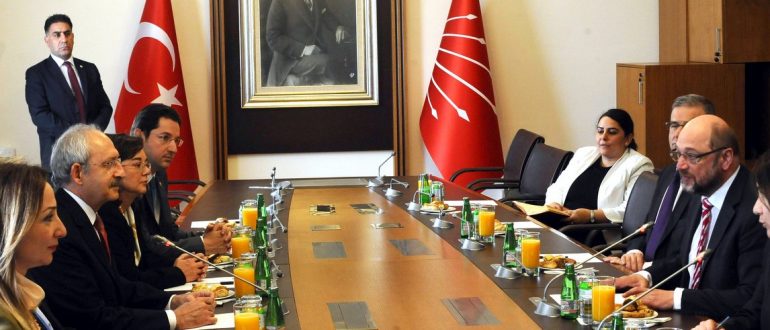“Preaching to the converted”: Euroscepticism, education and cross-border experiences
A declining interest in European affairs among Europe’s younger generation was pointed out already before the start of the financial and economic crises. The deteriorated economic situation seems to have accelerated the rise of Euroscepticism among a wide range of stakeholders throughout the European Union.
A declining interest in European affairs among Europe’s younger generation was pointed out already before the start of the financial and economic crises. The deteriorated economic situation seems to have accelerated the rise of Euroscepticism among a wide range of stakeholders throughout the European Union. Euroscpeticism relates to sceptic or oppositional feelings towards Europe and the European Union and is clearly present among the EU’s younger citizens due to the severe austerity measures and high unemployment levels that currently affect this generation throughout the continent. Besides this being problematic for (further) European integration, a continuing rise of Euroscepticism could eventually undermine the legitimacy of the European Parliament (EP) and the EU’s democratic processes, which will pose risks to the fundaments of European cooperation.Euroscpeticism relates to sceptic or oppositional feelings towards Europe and the European Union and is clearly present among the EU’s younger citizens due to the severe austerity measures and high unemployment levels that currently affect this generation throughout the continent. Besides this being problematic for (further) European integration, a continuing rise of Euroscepticism could eventually undermine the legitimacy of the European Parliament (EP) and the EU’s democratic processes, which will pose risks to the fundaments of European cooperation.
I argue that among European youth there is a clear distinction in attitudes towards the “European Project” between those with higher and lower education levels (indicated by years of education). Youth with lower education levels are more Eurosceptic but are being insufficiently exposed to cross-border experiences in the EU. This calls for a rethinking of ways to bring Europe’s youth together to counteract the rise of Euroscepticism.
More education, more voting
Young people have been among the least likely voters to turn out in EP elections with participation rates declining at a faster pace than the overall trend. Average participation in the 2009 EP elections on the EU level stood at 43%, while participation of 18-24 year olds was only 29%, dropping from 33% five years earlier (European Commission, 2009).
Interestingly, last year’s Eurobarometer among European youth aged 15-30 revealed a relationship between years of education and likeliness to vote in elections, whereby those with more years of education are more likely to vote. Specifically for the pcoming EP elections 67% of those who left education at age 20 or older report they are likely to vote, whereas this is only 59% and 48% for the groups that left education at age 16-19 and age 15 or younger, respectively. Not voting “because they are against Europe and/or the European Union” was more often a reason for the group with the fewest years of education and for manual workers (European Commission, 2013).
These results lead to questions about the underlying differences regarding attitudes towards the EU among youth of various levels of education. A clear distinction can be found in the extend to which students participate in cross-border exchange programs, such as the Erasmus exchange programme for students in higher education, one of the flagship EU programmes to foster European citizenship.
Erasmus to the rescue
Already for decades the Commission has recognized the importance of fostering EU identity through this programme in its quest for “an ever closer union”. The programme serves both the economic goal of promoting EU labour market mobility and the goal creating “European citizens and a European identity feeling among the students, through participation in an international context” (Van Mol, 2009). Hence, the “underlying rationale of the Erasmus student exchange programme […] is that by living, working and studying together, Europeans become aware of their communalities and develop supranational identity” (Kuhn, 2012).
Empirical research into the effectiveness of the Erasmus programme has been limited, but in recent years interest has increased among academics. These studies show that mostly students with relatively more years of education participate in the programme and that these students already have a higher degree of European identity or are very likely to feel European (Kuhn, 2012; Oborune, 2013). “In contrast, low educated individuals who might respond strongly to cross-border mobility by adopting a European identity hardly participate in educational exchange because they leave school before these programs take pace” (Kuhn, 2012). Hence, Kuhn (2012) argues that the Erasmus programme is ineffective as it is “preaching to the converted.” Sigalas (2006) supports this view by stating “the Erasmus sojourn has a greater effect on students with an originally low level of European identity.” Moreover, those with less years of education, who do not participate in exchange programmes, generally trust people from other cultures less (Oborune 2013).
Thus the low participation rates of those with few years of education is a shortcoming, as this group has the least favourable attitude towards European affairs but would benefit most in terms of adopting a European identity. In that sense the Erasmus exchange programme is rather exclusive and it could be argued that it is not optimally applied to achieve its goal of fostering European citizenship.
Cross-boarder experiences for everyone
Hence, it seems imperative to come up with new ways to include those who have thus far been excluded from cross-border experiences, especially now with Euroscepticism on the rise. Policy measures must be taken such that more students can socialise in a European context to increase trust among youth from different nationalities. This point is underpinned by Fligstein (2008), who finds that the main source of a European identity is “the opportunity to positively interact on a regular basis with people from other European countries.” Unfortunately, he also found that the opportunity to do so is generally restricted to the more privileged layers of society, which generally includes those with few years of education.
Making sure that a larger proportion of Europe’s youth is exposed to similar experiences as those envisioned by the Erasmus programme can be done both inside and outside the educational spectrum. For example, more emphasis on cross-border experiences could be placed at an earlier stage of education and those who leave school at a younger age should be able to get more easily involved in cross-border apprenticeships.
However, these are merely suggestions to get an urgent discussion started. It is essential to be resourceful in this discussion so that even in times when budgets of existing programmes might be under attack, we do not scare away from progressive ideas that aim to make long term improvements to European cooperation. Only then we can make sure that the relatively lower educated will be more systematically included in cross-border European programmes to foster a European identity as a measure to counteract the rise of Euroscepticism. A failure to recognize this will let Europe’s young citizens with high and low education levels further drift apart in their attitudes towards the European Union and thereby pose serious threats to welfare and peace in the union on the long run.
Coen van de Kraats
Coen holds a Liberal Arts and Sciences degree from University College Utrecht (The Netherlands) and is currently doing a research masters in Economics at the Tinbergen Institute in Amsterdam. His contribution was submitted for >> [EPPC 2014]’s call for papers.
Leerzeile
References
European Commission (2009) “EB71.3 European Elections 2009. Post-electoral survey. Fist results: Focus on the vote by age group.” Eurobarometer 71.3 16 Dec. 2009.
European Commission (2013) “European Youth: Participation in Democratic Life.” Flash Eurobarometer 375, May 2013.
Van Mol, C. (2009) “The Influence of European Student Mobility on European Identity and Subsequent Migration Intentions.” Article for the International Bilingual Conference “Academic Mobility: New Research and Perspectives”, Tallinn University, 24-26 September 2009.
Kuhn, T. (2012) “Why educational exchange programmes miss their mark: cross-border mobility, education and European identity.” Journal of Common Market Studies 50.6: 994-1010.
Oborune, K. (2013) “Becoming more European after ERASMUS? The Impact of the ERASMUS Programme on Political and Cultural Identity.” Epiphany: Journal of Transdisciplinary Studies 6.1.
Sigalas, E. (2006) “Remaining proud of their national identity, yet uniting ever more closely? The Erasmus students as the role model European citizens.” Paper prepared for the 6th conference os ESCA-C, 19-20 May 2006.
Fligstein, N. (2009) “Who are the Europeans and how does this matter for politics?.” in Checkel, J. T. and P. J. Katzenstein European Identity. Cambridge University Press.
I argue that among European youth there is a clear distinction in attitudes towards the “European Project” between those with higher and lower education levels (indicated by years of education). Youth with lower education levels are more Eurosceptic but are being insufficiently exposed to cross-border experiences in the EU. This calls for a rethinking of ways to bring Europe’s youth together to counteract the rise of Euroscepticism.
More education, more voting
Young people have been among the least likely voters to turn out in EP elections with participation rates declining at a faster pace than the overall trend. Average participation in the 2009 EP elections on the EU level stood at 43%, while participation of 18-24 year olds was only 29%, dropping from 33% five years earlier (European Commission, 2009).
Interestingly, last year’s Eurobarometer among European youth aged 15-30 revealed a relationship between years of education and likeliness to vote in elections, whereby those with more years of education are more likely to vote. Specifically for the pcoming EP elections 67% of those who left education at age 20 or older report they are likely to vote, whereas this is only 59% and 48% for the groups that left education at age 16-19 and age 15 or younger, respectively. Not voting “because they are against Europe and/or the European Union” was more often a reason for the group with the fewest years of education and for manual workers (European Commission, 2013).
These results lead to questions about the underlying differences regarding attitudes towards the EU among youth of various levels of education. A clear distinction can be found in the extend to which students participate in cross-border exchange programs, such as the Erasmus exchange programme for students in higher education, one of the flagship EU programmes to foster European citizenship.
Erasmus to the rescue
Already for decades the Commission has recognized the importance of fostering EU identity through this programme in its quest for “an ever closer union”. The programme serves both the economic goal of promoting EU labour market mobility and the goal creating “European citizens and a European identity feeling among the students, through participation in an international context” (Van Mol, 2009). Hence, the “underlying rationale of the Erasmus student exchange programme […] is that by living, working and studying together, Europeans become aware of their communalities and develop supranational identity” (Kuhn, 2012).
Empirical research into the effectiveness of the Erasmus programme has been limited, but in recent years interest has increased among academics. These studies show that mostly students with relatively more years of education participate in the programme and that these students already have a higher degree of European identity or are very likely to feel European (Kuhn, 2012; Oborune, 2013). “In contrast, low educated individuals who might respond strongly to cross-border mobility by adopting a European identity hardly participate in educational exchange because they leave school before these programs take pace” (Kuhn, 2012). Hence, Kuhn (2012) argues that the Erasmus programme is ineffective as it is “preaching to the converted.” Sigalas (2006) supports this view by stating “the Erasmus sojourn has a greater effect on students with an originally low level of European identity.” Moreover, those with less years of education, who do not participate in exchange programmes, generally trust people from other cultures less (Oborune 2013).
Thus the low participation rates of those with few years of education is a shortcoming, as this group has the least favourable attitude towards European affairs but would benefit most in terms of adopting a European identity. In that sense the Erasmus exchange programme is rather exclusive and it could be argued that it is not optimally applied to achieve its goal of fostering European citizenship.
Cross-boarder experiences for everyone
Hence, it seems imperative to come up with new ways to include those who have thus far been excluded from cross-border experiences, especially now with Euroscepticism on the rise. Policy measures must be taken such that more students can socialise in a European context to increase trust among youth from different nationalities. This point is underpinned by Fligstein (2008), who finds that the main source of a European identity is “the opportunity to positively interact on a regular basis with people from other European countries.” Unfortunately, he also found that the opportunity to do so is generally restricted to the more privileged layers of society, which generally includes those with few years of education.
Making sure that a larger proportion of Europe’s youth is exposed to similar experiences as those envisioned by the Erasmus programme can be done both inside and outside the educational spectrum. For example, more emphasis on cross-border experiences could be placed at an earlier stage of education and those who leave school at a younger age should be able to get more easily involved in cross-border apprenticeships.
However, these are merely suggestions to get an urgent discussion started. It is essential to be resourceful in this discussion so that even in times when budgets of existing programmes might be under attack, we do not scare away from progressive ideas that aim to make long term improvements to European cooperation. Only then we can make sure that the relatively lower educated will be more systematically included in cross-border European programmes to foster a European identity as a measure to counteract the rise of Euroscepticism. A failure to recognize this will let Europe’s young citizens with high and low education levels further drift apart in their attitudes towards the European Union and thereby pose serious threats to welfare and peace in the union on the long run.
Coen van de Kraats
Coen holds a Liberal Arts and Sciences degree from University College Utrecht (The Netherlands) and is currently doing a research masters in Economics at the Tinbergen Institute in Amsterdam. His contribution was submitted for >> [EPPC 2014]’s call for papers.
Leerzeile
References
European Commission (2009) “EB71.3 European Elections 2009. Post-electoral survey. Fist results: Focus on the vote by age group.” Eurobarometer 71.3 16 Dec. 2009.
European Commission (2013) “European Youth: Participation in Democratic Life.” Flash Eurobarometer 375, May 2013.
Van Mol, C. (2009) “The Influence of European Student Mobility on European Identity and Subsequent Migration Intentions.” Article for the International Bilingual Conference “Academic Mobility: New Research and Perspectives”, Tallinn University, 24-26 September 2009.
Kuhn, T. (2012) “Why educational exchange programmes miss their mark: cross-border mobility, education and European identity.” Journal of Common Market Studies 50.6: 994-1010.
Oborune, K. (2013) “Becoming more European after ERASMUS? The Impact of the ERASMUS Programme on Political and Cultural Identity.” Epiphany: Journal of Transdisciplinary Studies 6.1.
Sigalas, E. (2006) “Remaining proud of their national identity, yet uniting ever more closely? The Erasmus students as the role model European citizens.” Paper prepared for the 6th conference os ESCA-C, 19-20 May 2006.
Fligstein, N. (2009) “Who are the Europeans and how does this matter for politics?.” in Checkel, J. T. and P. J. Katzenstein European Identity. Cambridge University Press.



